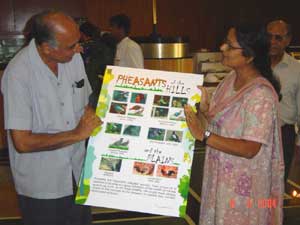NEWS………. By Dr.Susan Sharma
On 8th May 2004, IndianWildlifeclub.com released two posters on pheasants from India.
Mr.Samar Singh, President, World Pheasant Association (India Chapter) was the chief guest who released the posters at a quiet function at India Habitat Centre, New Delhi.
The events leading up to the release went like this. During April 5-10, 2004, the third international Galliformes Symposium was held at Wildlife Institute of India, Dehra Dun. I attended the symposium and took time off after the symposium to visit 'Dhanaulti',
a hill station near Mussourie, about 6000-7000 ft high and which is the natural habitat for some of the galliformes including the khalij, koklass and monal. Speaking to a school teacher at Dhanaulti, it shocked me to hear from her that in those parts pheasants
and partridges were still being killed for meat. While she had never set her eyes on a monal ( In fact when I showed her a picture of Himalayan Monal, she happily told me it is a peacock. ) she was also unaware that monal was the state bird of Uttaranchal,
her state. That is when I decided that I would use the pictures I had taken in 'Sarahan Pheasantry' in Himachal Pradesh to make simple posters, which will have the common names of pheasants in English and in Hindi.
Coming from a scientific symposium where international experts talked about saving the last of the many species of pheasants by conservation breeding and other methods, the encounter with the schoolteacher with her students numbering over
a hundred, was an eye opener. Here we are, letting the birds slip away before our very eyes, in the land of their birth. IWC.com is looking for sponsors who will help us in reaching these posters to all schools in Himachal Pradesh, Uttar Pradesh, Uttaranchal
, Arunachal Pradesh, Sikkim and Nagaland- the last natural habitat of rare pheasants and other galliformes.
|

|
"Pheasants of the Hills & the Plains" Mr. Samar Singh and Dr. Susan Sharma are seen in the picture. " Pheasants, the most spectacular birds" makes Mr. Samar Singh beam as Mr. Junaid, research student working
with galliformes, looks on.
Views…….
"The ecological, economic and aesthetic importance of Galliformes must not be undermined. The gorgeous Indian Peacock is our National Bird. And the other forms of pheasants, partridges, quails etc. have
also been contributing directly or indirectly to human welfare.
…The state of Uttaranchal is the natural home of several species of pheasants and other galliformes. These beautiful birds are closely linked to the lifestyles of our people, their survival and well-being
is certainly essential. "
-Narayan Datt Tiwari
Chief Minister, Uttaranchal
"Pheasants have an important role in the eco-system and their food niche incorporates a variety of crop pests and insects. Our National Legislation, the wild life (protection) Act, 1972 prohibits hunting and or trade of all pheasants. However, the present scenario
calls for more concerted efforts with wider publicity, since these birds are threatened by poaching and habitat degradation. Hence pheasants, like any other endangered species, require the much needed public support.
N.K. Joshi
Director General of Forests & Special Secretary, Government of India, Ministry of Environment & Forests.
"India is home the home of about one-third of all pheasants in the world. In fact, China and India account for more than two-third of the world's total number of pheasant species. Hence these two countries
have a very special role and importance in the movement for the conservation of pheasants, in particular, and galliformes, in general.
M.S. Swaminathan
International Patron, World Pheasants Association.
( All the above views are taken from the publication of abstracts of the Third International Galliformes Symposium 2004.)